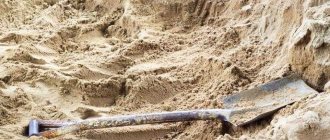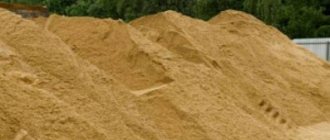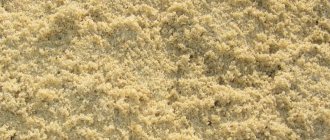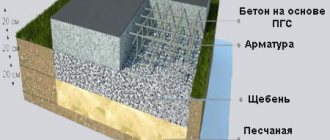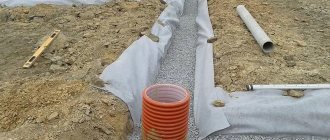Kinds
A natural material, sand, is a loose mixture containing granules up to 5 mm in size. It is this material that is formed during the destruction of (natural) rocks, after which it is mined and processed.
Depending on the location, sands can be: alluvial, sea, lake, ash, deluvial. It is interesting that the sand that is found on the seabed or river has a softer and more rounded shape.
It is not homogeneous, as it consists of different granules (different in size and shape). Today, there are two types of sand: natural and artificial.
There are a sufficient number of different types of sand.
River
River type sand is extracted from the river bed. Its advantage over others is that it is quite clean. It contains no foreign impurities such as clay, dust, debris, and so on.
River
Career
Washed sand (extracted from a quarry). This material is extracted from a quarry and washed with large amounts of water. This is necessary in order to wash away the clay and other impurities.
Career
Seeded
Seeded type sand, sand extracted from a quarry This type of sand is also extracted from a quarry, but it undergoes a different type of processing - sifting in order to rid the material of large stones.
Seeded
Speaking of practice, it is used during plastering work, as well as to prepare an asphalt concrete mixture.
For construction
If we talk about GOST 8736-2014, then this material is a mixture of large grains with a diameter of 5 mm. It is formed after the destruction (natural type) of rocks. It is extracted using special equipment.
For construction
Artificial
Artificial sand, heavy. It is obvious from the name that this type of sand is not natural.
It is obtained by crushing marble, granite, limestone, pumice and so on. Speaking about the shape of sand grains, in the artificial version, they are sharp, and the surface is rough.
Artificial
This sand is used for working with plaster. Also, it is often used as a water filter, but in large volumes (swimming pools), when constructing construction sites, and so on. It is also used in construction when it is necessary to make cement mortar. This helps save cement (less of it is needed than with simple sand).
Sand has many characteristics and properties that can rightfully be called unique:
- does not shrink. This important property helps the bulk material to be used as a base;
- sand has no cohesion, meaning it crumbles. Dry sand cannot be held in a vertical plane, but its scatterability is very small, the angle of which ranges from 280-300. If we talk about wet sand, then on the contrary, it has a high adhesion rate;
- waterproof. Absolutely any layer of sand is permeable to any amount of water. It is this positive property that is used to filter water;
- sand has the property of uniform pouring. That is, it will pour out through the holes at the same speed.
For more information about the properties of sand, watch the video:
Sand is hard rock that has been broken down into small pieces by water and wind over millions of years. Basically, such pieces are small, no more than a few millimeters in size, grains of quartz - the most common mineral on Earth, consisting of silicon dioxide molecules. Silicon dioxide is not only found in the form of quartz on sandy beaches. You can easily find it in a package of chips or crackers. It is used there as a leavening agent - this means that it prevents food particles from sticking together. But this “sand,” which you can eat along with crackers, is much finer than usual, and it does not harm the body.
Let's see what sand can consist of, besides quartz.
The transparent crystals here are grains of quartz, but besides them we also see grains of other minerals. The fact is that sands are actually very different, depending on their origin. Volcanic sands, for example, may contain pieces of red minerals, causing the beach to appear red. There are several beaches in the world where the green mineral chrysolite is found in the sand. That's why the beaches there are green. And in some countries there are black sands containing many heavy minerals such as hematite or magnetite.
But the most interesting thing is that, in addition to minerals, sand, especially sea sand, often contains fossilized remains or shells of simple animals and plants that lived millions of years ago.
These shells are usually made of calcium carbonate - that is, chalk. This is the same chalk that is used in the classroom to write on the blackboard, or on the street to draw on the asphalt.
So in fact, sands are very different, and the composition of one sand can be very different from the composition of another.
Blog
Why do older people's hair turn gray?
Nobody knows for sure.
Moreover, scientists cannot yet unambiguously answer the question of why this is necessary or how it happens. But there are some ideas on this matter. Let's start with how. There are two main versions of how people go gray. They both agree that it occurs when the cells from which hair grows stop producing the pigment proteins that give hair its color. According to the first version, this is simply due to the aging of these cells. Over time, errors can accumulate in the DNA of any cells, and they stop working normally. In the case of the cells that are responsible for hair growth, this causes them to lose the ability to produce pigments normally. December 8Aging
- Biology
Blog
Are snails born with a shell?
Yes.
A snail's shell is part of its body. The shell is the external skeleton of a snail and many other mollusks. It consists of several layers. This is a base of organic materials on which calcium carbonate (the same chemical that chalk is made of) is deposited. The shell is produced by a part of the snail's body called the mantle. The shell serves as protection from predators, to retain moisture and so that the snail's muscles can attach to it. Snails have intestines inside their shells. Small snails are born with a translucent thin shell, which grows along with the snail itself. December 8
- Zoology
Blog
What is more, cells in a person or stars in our galaxy?
Cells in a person.
Of course, it is difficult to calculate the exact number of stars in our galaxy, which measures approximately 100,000 light years and weighs 750 billion times the mass of our Sun. But you can guess. According to modern estimates, there are from 200 to 400 billion stars in our galaxy. Fantastically a lot. But it turns out that the human brain alone, which makes up only 2 percent of our body mass, contains about 100 billion cells. And in the entire body there are approximately 100 trillion cells. What is this number? That's a one followed by 14 zeros, 100,000,000,000,000, which is at least 250 times the number of stars in our galaxy. December 2nd
- Astronomy
More
Properties
In order for a builder to choose the sand he needs, he must know five basic properties that play an important role when choosing a material.
Sand granule sizes
This is an important property that is determined by sifting sieves of different diameters.
The size of the granules must be known in order to determine how much water needs to be added during the preparation of the mixture. This will help influence the amount of binder material itself.
There are three faction options:
- small – 1.0…2.0;
Small
- average – 2.0…2.5;
Average
- large – 2.5.
Large
Compound
It is also worth understanding whether the sand contains additional impurities, such as clay, dust. This indicator is measured as a percentage. For example, sea sand has 0% impurity, and quarry sand can reach up to 9%
Filtration
The filtration coefficient tells us how far water can penetrate into the material per day. Logically, the cleaner the water, the higher the number. For example, if we talk about sea sand, then the water will pass at 22m, and in quarry sand - 5m;
Radioactivity
This is also an important characteristic that allows you to find out how radioactive the sand is, that is, it is dangerous for humans or not.
Bulk mass
This data shows how much mass the material has per unit volume, in other words, density.
Sand classification
The composition of sand includes rock particles that, under the influence of natural phenomena, have turned into small (from 0.05 mm to 5 mm in diameter) round or pointed grains. This bulk material is of inorganic origin and does not react with the components of mortars and concrete. Its presence in these compositions helps to reduce their shrinkage during hardening due to its ability to slowly settle in the mixture.
Classification of natural sand.
Sand is classified according to its type and origin, the presence of organic or inorganic impurities, the composition and nature of the grain shape, stability and strength, depending on the physical and mechanical properties. Based on their origin, sands are divided into natural and artificial. Natural material is obtained during the development of sand and gravel or sand deposits. Depending on the location, it can be sea, river, ravine or mountain. Sea and river types of sand have a more rounded grain shape than mountain sand, and their composition contains less contamination with harmful impurities. Based on grain size, natural sands are divided into 4 groups: coarse, medium, fine and very fine.
Chemical formula
The chemical formula of sand is quite simple, it is silicon dioxide: SiO2 - 98%, the rest AI2O3 and Fe2O3. This sand formula is of the quartz type, but what is most interesting is that all calculations come from it. This is due to the fact that it has the purest composition.
The chemical formula of river sand has been known to us since school; it is SiO2, that is, silicon dioxide. Sand gets its color (yellowish tint) due to the fact that it contains iron oxide.
Speaking about the purification of sand, this happens naturally - by the influx of the river. This is what washes away all the dust, clay, unnecessary particles.
The safe chemical formula of sand allows this material to be used even for children's playgrounds and sports stadiums. When purchasing material, you should ask for a passport for the product and pay attention to the fact that everything there is in accordance with GOST, that the sand was extracted from the bottom of the river and that it is a clean material.
The use of such material varies, ranging from the glass industry to construction. River sand chemical formula allows you to correctly calculate the density of the sand, which ultimately will allow you to correctly calculate the required amount of sand.
Glue is one of the most important components when carrying out any type of repair and the issue of purchasing it is worth thinking about in advance. Click on the link to see its consumption.
From time immemorial, the stove in Rus' was considered the most reliable, and sometimes the only source of heat in the house. Here you will learn how to prepare a solution for plastering a stove.
Indoor wall decoration is an indispensable component of a cozy and beautifully decorated interior. It's all about decorating a room with a stone look using panels.
The chemical formula of river sand does not differ from other types of sand, and if it is written down correctly, then you can easily correctly calculate the density N, on which many characteristics of the material will depend.
The chemical sand formula is the same for all types of material, and this should be taken into account when making various calculations necessary for working with such material.
Characteristics
The chemical formula of sand is known in advance, but in addition to it, it is necessary to remember that there are other important characteristics of the material:
- density. The specific density of sand (bulk) is determined not only by the chemical formula of the sand. It is determined by the amount of clay that is in its composition. Interestingly, the density without impurities is 1300 kg/cubic meter;
- if the value is higher than this indicator, this indicates that the material contains too much moisture, as well as clay (if possible, other materials);
Density
- sand moisture formula is as follows: W= (m1-m2/m2)*100;
Humidity
- specific weight. This indicator is needed so that the builder can find out the unit of volume in the most dense state. The value is defined as the ratio of mass (dry version only) to the volume it occupies;
Specific gravity
- as practice has shown, this value can fluctuate between 2.55-2.56. Moreover, each type of sand has a different specific gravity, while the formula of sand in chemistry is the same;
- volumetric weight. This value shows the unit of volume in its natural state, taking into account all moisture, impurities, and so on. As in the previous characteristic, this value can also be different depending on the class of material;
- speaking about the average value, it is equal to 1500-1800 kg per cubic meter. Based on the standards, GOST-8736-77, one cubic meter contains 1.6 tons.
Classification by rock destruction
This material is formed during the destruction of hard rocks. Depending on the accumulation conditions, sands can be:
- alluvial;
- sea;
- deluvial;
- aeolian;
- lake
When a material arises during the activity of reservoirs and watercourses, its elements will have a rounded round shape.
Size module
The sand fineness modulus formula has the following form: M= A2.5+A1.25+A0.53+A0315+A014/100. This value shows the residues on all sieves, which is divided by one hundred. According to GOST, this figure is considered conditional, but it allows you to evaluate the material by size.
This characteristic needs to be known in order to determine the required volume of water for the future solution. The quality of the work performed will depend on it.
In cases of high requirements, it is worth using alluvial sand. Even if you take simple natural sand, which contains grains ranging in size from 0.1 to 5 mm, and clean it correctly, it can be used in the following areas:
- during the construction of residential buildings;
Construction of houses
- for road construction;
Road construction
- used when pouring the foundation and so on.
Pouring the foundation
Since sand contains minerals, it can be divided into several types:
- feldspar;
- dolomite;
Dolomite
- quartz;
Quartz
- limestone.
Limestone
The most reliable and high-quality is quartz. This is due to the fact that it is very durable and durable. It has a size of 0.05-1 mm. It contains mica and feldspar and other, more durable materials. Each type of sand has its own advantages and its own areas of application.
In order to correctly select the right amount of sand and make the right solution during construction work, you need to know the chemical formula of the material, its density, specific gravity and other characteristics.
Applications and characteristics of sea sand
Sea sand can be used in the production of building mixtures, the manufacture of aggregates, plastering work, laying road bases, building fences and fences, as a filler for construction grouts and dyes. The production of such sand is regulated by GOST 8736-93.
Fractions can vary from 2.5 to 3.5 Mk, which determines the particle size modulus. The grain density is equal to the limit from 2 to 2.8 g/cm3. Sea sand should be completely free of foreign impurities, but in some fractions you can find a low content of clay and dust particles. Sea sand is characterized by labor-intensive production, which makes its cost higher than quarry alluvial sand.
Application and extraction of sand
Sand is a material that must be extracted using special equipment. There are several places where this material is obtained:
- mountain quarries and plains. In such an area, the sand is very polluted. It contains stones, dust, clay, and so on. It is logical that after extracting it, you need to sift the sand and then rinse it with plenty of water;
Mining quarries
- such material has a scope of application - the production of asphalt concrete and for plastering work;
- river bottom. Here you can get the purest sand, which is washed by the river flow, washing away clay, silt, and so on. Sand can be obtained medium-grained, which can later be used during finishing work;
Mining from the river bottom
- bottom of the sea. Here you can find sand that contains a lot of impurities. After its extraction, it goes through many degrees of purification and special enrichment. Used in construction.
Mining from the bottom of the sea
Today, there are several options for sand extraction, based on its location:
- open type method. This method of sand extraction is carried out in places where the material’s moisture is natural, that is, the deposit is not watered. Even if there is some water in the quarry, it is first removed (using drainage systems), after which the sand is dried;
Open method
- When it comes to extracting sand in quarries, they use special equipment such as an excavator, dump truck, and so on. When the sand is extracted, it is sifted through a special sieve in order to divide it into classes of a certain fraction;
- The cleanest sand is considered first class, since it has better adhesion and can be used during construction. Sand of the second class is considered worse, which can be used for laying bricks and sidewalks;
- underwater method. The name itself speaks for itself. This option is used to extract sand from the bottom of a river, sea or lake. Sand is extracted using special floating devices - dredgers, which are installed on pontoons, secured to the bottom with an anchor;
Underwater method
- the shells suck up the sand and are crushed, after which the sand is thrown out to the storage site. The water that is absorbed with the sand is returned back to the reservoir. With this extraction method, the material is clean and can be used in various construction works.
Classification
So, according to the place of origin, sand is usually classified into the following types:
river sand
River sand is mined from the bottom of rivers. It is characterized by natural purity and good water-permeability qualities. The size of sand grains in river sand ranges from 0.3 to 0.5 mm.
This type is used for the preparation of concrete solutions, cement screeds, treatment filters, and drainage structures. It is worth noting that when preparing a concrete mixture, this type of sand quickly settles, so the solution must be constantly stirred. The cost of river sand ranges from 600 to 800 rubles per 1 m3.
Quarry sand
Quite logically, quarry sand is mined using the open-pit method and includes impurities in its composition: dust particles, stones. Sand grains of quarry sand are much smaller than those of river sand, their sizes range from 0.6 to 3.2 mm.
In its original unprocessed form, the building material can be used to construct trenches or as a foundation foundation. Typically, leading manufacturers wash and screen quarry sand. In this case, it can be used when performing plastering and finishing work, to create an asphalt concrete mixture, and to form a screed.
Sea sand
This non-metallic mineral is extracted from the seabed using hydraulic projectiles. There are practically no foreign impurities in it, and salt is involved in purification.
This type of sand is considered the most popular. It is used everywhere, from the creation of concrete structures to the formation of finely dispersed dry mixtures. But, despite the unique characteristics of this building material, there is a shortage of it, since it cannot be mass produced.
Sometimes construction sand is considered a separate type. But, as a rule, it means both river and quarry sand. River sand can be of two colors - yellow and gray, and quarry sand - brown and yellow.
But it turns out that in nature there is also black sand , which shines like metal. It can be found in different parts of the world. This type of sand is formed as a result of geological processes.
This mineral consists of dark-colored heavy minerals and is formed by washing out the light components. The main minerals are magnetite, ilmenite, hematite.
Such sands are characterized by high radioactivity - 50-300 microroentgens per hour, but sometimes this parameter can reach a thousand microroentgens per hour. Due to its high radioactivity, this mineral is not used in construction and economic activities.
Artificial sand
It is worth noting that the above types of sand are natural, as they were formed by the natural destruction of rocks. But there is also artificial sand , created by crushing marble, limestone, and granite.
The most popular among artificial types of sand is quartz. It is made by grinding and dispersing the white quartz mineral to obtain a homogeneous fraction. It differs from natural types of sand in that it does not contain impurities and has a homogeneous composition. These advantages allow you to accurately calculate the parameters of a structure made on quartz sand.
It has found its application in the creation of decorative and finishing materials, welding materials. It is also used in the production of concrete, but quite rarely.


